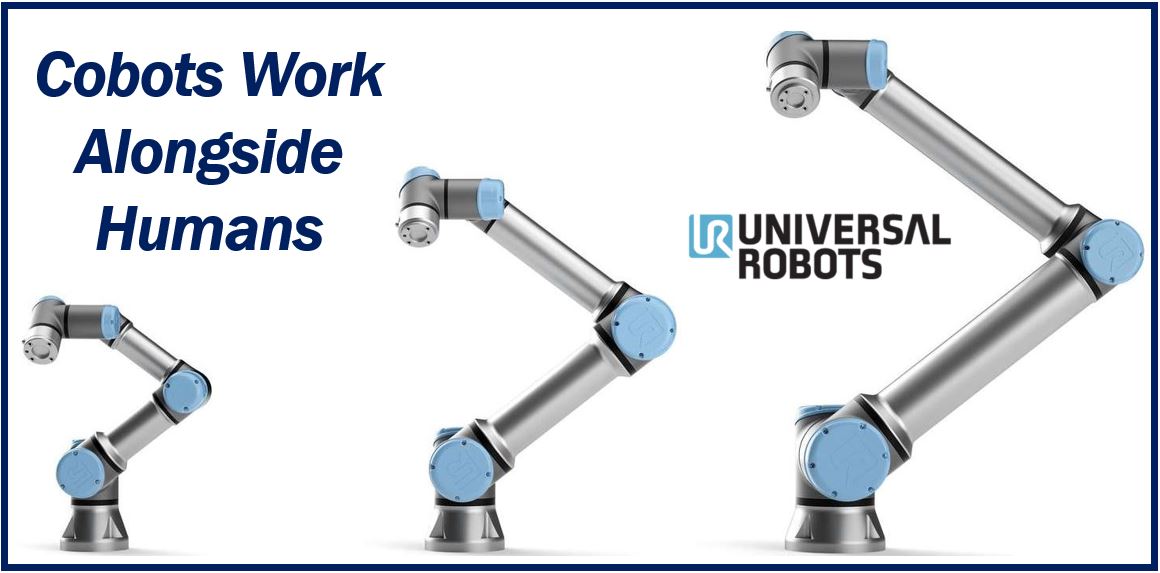A cobot is a collaborative robot. It has been designed to work alongside humans in the same workplace. The word Cobot is an abbreviation of two words – collaborative and robot. They have inherent safety features because they work together with humans. Universal Robots, for example, based in Odense, Denmark, which manufactures smaller flexible collaborative robot arms, released UR5, its first cobot, in 2004. Over the past decade and a half, cobot technology has advanced significantly.

There are plenty of automation cases where cobots and humans working together provide value, mainly in operations where the employees cannot – or do not want to – completely automate. In general, the collaborative robots are predominantly tested and effectively used for repetitive tasks whereby intelligent support systems of the cobots assist workers, rather than replacing them.
Cobots versus the traditional/classic industrial robots
1. Designed to collaborate
A traditional industrial robot has not been designed to collaborate with people. It is designed to complete a very specific pre-defined task without the need for collaboration with any human within their physical workspace.
They are not designed with human safety as a key priority (there are variations); they just need to do their task. Where industrial robots are used, one will typically find safety measures. Many of them are fully caged and shielded from humans on the work floor, with fences or other physical barriers.
As we have seen earlier, cobots are an improvement on traditional robots. This is the major reason why they have become so popular in almost all production sectors; due to their ability to work harmoniously with human employees.
2. Lightweight and Portable
A collaborative robot in general is also much more lightweight than an industrial robot, again depending on the type.
That has to do with the typical tasks of the modern industrial robot arm, the mentioned safe collaboration aspect and the fact that cobots are typically mobile and/or can be easily moved. This is not the case with your average big industrial robot.
3. Smart
A collaborative robot is way smarter than a classic industrial robot. This does not mean that cobots are more complex and other industrial robots simple.
What it does mean is that cobots are equipped with sensors, smart technologies, and systems. These are are linked with the robots’ IoT and specific systems, such as warehouse management systems, depending on the case. This need for sensors is because the cobots need to safely assist human beings. Their smart technologies and sensors make them sensitive to people around them, i.e., where they are, what they are doing, etc.
4. Simple and easy to use
A cobot is also simpler than most traditional industrial robots. This may seem like a contradiction with the previous point, but it is not.
The vast majority of cobots do not require sophisticated skills to program. In most cases, if the employee knows how to use a tablet or smartphone, they can program or teach a cobot. One does not need a team of highly skilled computer engineers or roboticists to operate them.
Universal Robots has also simplified the process of setting up cobots by fitting them with an intuitive user interface that is plug and produce, eliminating the need for any special electrical installations; just connecting them to a regular power outlet.
5. Unlimited Application
Traditional robots have specific tasks. They have been designed to do certain skills and nothing else. Collaborative robots, on the other hand, are not restricted to a specific industry or application. On the contrary, they are very flexible and efficient in any task one programs them to perform. One can shift the cobots from one task to another and reuse the previous programs for tasks which are recurrent.
Conclusion
The diverse challenges in making robots work alongside staff in a secure and valuable way have been gradually solved. We are currently at a tipping point whereby there aren’t too many hurdles anymore to leverage them for real-life applications. This collaborative aspect is essential for the design, possibilities, characteristics, and evolutions of cobots.

